TOP 5 CITIES IN THE WORLD
The world is home to some 4,416 cities - from the crumbling grandeur of Rome to the
bristling, ultra-modern towers of Shanghai. It includes tiny Adamstown, a microscopic settlement in the Pitcairn
Islands with a population of only 48; it includes Venice, a floating city laced by idyllic canals and
breathtaking palazzos. And like the people who inhabit them, each has its own distinctive personality, allure,
photo-worthy moments, and reasons to pay them a visit. Here, in our humble opinion, are the world’s most special
cities.
1/Tokyo
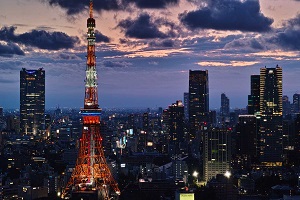
History
Architecture in Tokyo has largely been shaped by Tokyo's history. Twice in recent history has the metropolis been
left in ruins: first in the 1923 Great Kantō earthquake and later after extensive firebombing in World War II.
Because of this, Tokyo's urban landscape consists mainly of modern and contemporary architecture, and older
buildings are scarce.
Tokyo features many internationally famous forms of modern architecture including Tokyo International Forum, Asahi
Beer Hall, Mode Gakuen Cocoon Tower, NTT Docomo Yoyogi Building and Rainbow Bridge. Tokyo also features two
distinctive towers: Tokyo Tower, and the new Tokyo Skytree, which is the tallest tower in both Japan and the
world, and the second tallest structure in the world after the Burj Khalifa in Dubai.
Food

|
Tokyo is one of the world's most exciting dining destinations. The city features a wide range of both local
and regional Japanese cuisine in addition to all types of international fare. Its top restaurants have
accrued more Michelin stars than both Paris and New York combined. But good food can be found at every price
range from cheap hole-in-the-wall joints to expensive high-class restaurants with every budget in between.
As Japan's political center for over four centuries, Tokyo has naturally exerted great influence on Japanese
cuisine. Consequently, some Tokyo specialties have become so popular that they are now known as the standard
version of the dish rather than a local specialty.
|
Population
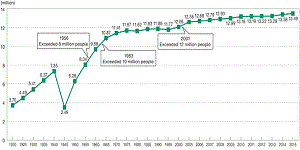 |
Tokyo's 2020 population is now estimated at 37,393,128. In 1950, the population of Tokyo was 11,274,641.
Tokyo has grown by 137,020 since 2015, which represents a 0.07% annual change. These population estimates
and projections come from the latest revision of the UN World Urbanization Prospects. These estimates
represent the Urban agglomeration of Tokyo, which typically includes Tokyo's population in addition to
adjacent suburban areas.
According to recent estimates, the 23 wards that make up the city of Tokyo had an approximate 2016
population of 9,262,046. The 23 wards made up the boundaries of the historic city of Tokyo, which was
officially dissolved in 1943 when it merged with the prefecture. Today, Tokyo extends way beyond the
original city boundaries, and is one of the largest urban sprawls in the world, which doesn't make it easy
to explain exactly how many people live in Tokyo. |
culture
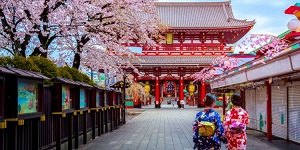
|
There are two main religions in Japan: Shinto and Buddhism. Shinto is a Japanese religion, while Buddhism
was imported in the 6th century from China. A recent poll found that 39% of Japanese people identify as
Buddhist, 3.9% as Shinto and 2.3% as Christian.
In Japan, the
largest holiday is the New Year’s celebration. During spring and summer, celebrations for the gods of the
land and sea, or Matsuri, take place. Each town holds its own Matsuri, and these celebrations are widely
attended by all.
The traditional
family unit in Japan is called “Kazoku,” comprising of a mother, father and their children. Traditionally,
the Kazoku often live with their elderly parents. However, more recently, three generation household numbers
have fallen in favor of more modern arrangements.
|
Personal safety
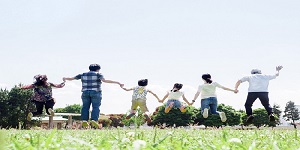
|
Tokyo ranks fourth for personal safety.In fact, Tokyo is considered a very safe city in this regard
because people are not much likely to encounter violence, theft or personal crimes that still take place
everyday. world street. However, the city still faces corruption and organized crime, which is why it is
not ranked higher.However, although organized crime like the yakuza still exists, residents of Tokyo
are not really affected by their activities in the city. This is quite different when comparing Tokyo
with other cities in the world.
|
2/Newyork
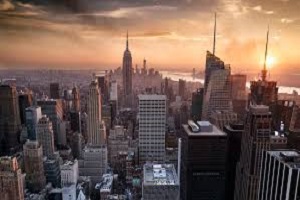
Early history
In 1609, the English explorer Henry Hudson rediscovered New York Harbor while searching for the Northwest
Passage to the Orient for the Dutch East India Company.He proceeded to sail up what the Dutch would name the
North River (now the Hudson River), named first by Hudson as the Mauritius after Maurice, Prince of Orange.
Hudson's first mate described the harbor as "a very good Harbour for all windes" and the river as "a mile broad"
and "full of fish". Hudson sailed roughly 150 miles (240 km) north, past the site of the present-day New York
State capital city of Albany, in the belief that it might be an oceanic tributary before the river became too
shallow to continue.He made a ten-day exploration of the area and claimed the region for the Dutch East India
Company. In 1614, the area between Cape Cod and Delaware Bay was claimed by the Netherlands and called
Nieuw-Nederland (New Netherland).
The first non-Native American inhabitant of what would eventually become New York City was Juan Rodriguez
(transliterated to Dutch as Jan Rodrigues), a merchant from Santo Domingo. Born in Santo Domingo of Portuguese
and African descent, he arrived in Manhattan during the winter of 1613–14, trapping for pelts and trading with
the local population as a representative of the Dutch. Broadway, from 159th Street to 218th Street in Upper
Manhattan, is named Juan Rodriguez Way in his honor.
Cuisine
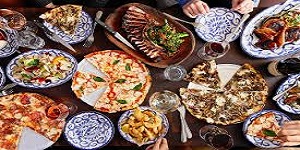 |
The cuisine of New York City comprises many cuisines belonging to various ethnic groups that have entered
the United States through the city. Almost all ethnic cuisines are well represented in New York City, both
within and outside the various ethnic neighborhoods.
New York City was also the founding city of New York Restaurant Week which has spread around the world due
to the discounted prices that such a deal offers. In New York City there are over 12,000 bodegas, delis and
groceries and many among them are open 24 hours a day, 7 days a week.Much of the cuisine usually associated
with New York City stems in part from its large community of Ashkenazi Jews and their descendants. The world
famous New York institution of the "Delicatessen," commonly referred to as a "Deli," was originally an
institution of the city's Jewry. |
Culture movements
 |
The city is the birthplace of many cultural movements, including the Harlem Renaissance in literature and
visual art; abstract expressionism (also known as the New York School) in painting; and hip hop, punk,
salsa, freestyle, Tin Pan Alley, certain forms of jazz, and (along with Philadelphia) disco in music. New
York City has been considered the dance capital of the world. The city is also frequently the setting for
novels, movies (see List of films set in New York City), and television programs.
Artists have been drawn into the city by opportunity, as the city government funds the arts with a larger
annual budget than the National Endowment for the Arts, and New York is a major center of the global art
market which grew up along with national and international media centers. |
Nightlife
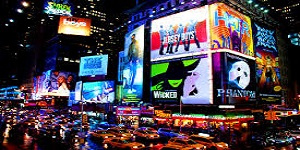 |
NYC is rightfully known for its nightlife. Whether that means sophisticated cocktail dens, friendly dive
bars or bottle-service-only dance clubs, the City’s after-dark entertainment is just as electrifying as it
ever was.
In this section, find out where to drink, dance and listen to music—all around the five boroughs.At night
,there are many things take people's attention,many kinds of entertainment that is available and generally
more popular from the late evening into the early hours of the morningIt includes pubs, bars, nightclubs,
parties, live music, concerts, cabarets, theatre, cinemas, and shows. |
Population
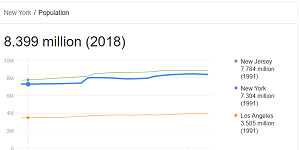
|
In 2017, the city had an estimated population density of 28,491 inhabitants per square mile (11,000/km2),
rendering it the nation's most densely populated of all municipalities (of more than 100,000), with several
small cities (of fewer than 100,000) in adjacent Hudson County, New Jersey having greater density, as per
the 2010 census Geographically co-extensive with New York County, the borough of Manhattan's 2017 population
density of 72,918 inhabitants per square mile (28,154/km2)makes it the highest of any county in the United
States and higher than the density of any individual American city.
|
3/Seoul

History
Seoul is first recorded as Wiryeseong, the capital of Baekje (founded in 18 BC) in the northeastern area of modern
Seoul. There are several city walls remaining in the area that date from this time. Pungnaptoseong, an earthen
wall located southeast Seoul, is widely believed to have been at the main Wiryeseong site. As the Three Kingdoms
competed for this strategic region, control passed from Baekje to Goguryeo in the 5th century, and from Goguryeo
to Silla in the 6th century.
Following the war, Seoul began to focus on reconstruction and modernization. As South Korea's economy started to
grow rapidly from the 1960s, urbanization also accelerated and workers began to move to Seoul and other larger
cities.
Until 1972, Seoul was claimed by North Korea as its de jure capital, being specified as such in Article 103 of the
1948 North Korean constitution
Food
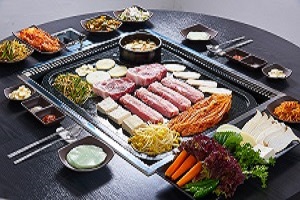 |
Korean cuisine is the customary cooking traditions and practices of the culinary arts of Korea. Korean
cuisine has evolved through centuries of social and political change. Originating from ancient agricultural
and nomadic traditions in Korea and southern Manchuria, Korean cuisine has evolved through a complex
interaction of the natural environment and different cultural trends.
Korean cuisine is largely based on rice, vegetables, and (at least in the South) meats. Kimchi is served at
nearly every meal. Commonly used ingredients include sesame oil, doenjang (fermented bean paste), soy sauce,
salt, garlic, ginger, gochugaru (pepper flakes), gochujang (fermented red chili paste) and napa cabbage.
Ingredients and dishes vary by province. Many regional dishes have become national, and dishes that were
once regional have proliferated in different variations across the country. Korean royal court cuisine once
brought all of the unique regional specialties together for the royal family. Foods are regulated by Korean
cultural etiquette. |
Culture
 |
The most endearing thing about the culture of Seoul is the constant wish to maintain peace and harmony. This
is evident from the acts of sharing food with one another, respecting elders, travelling in groups, etc.
Seoul is the cultural hub of South Korea, with several art galleries and museums, along with Buddhist
temples and monasteries as an epitome of architectural excellence.
The Lunar New Year, which falls on the first day of spring and Thanksgiving in Autumn are the two main
festivals celebrated by the people of Seoul. Time of harvest is celebrated with Chusok when the people pay
respect to their ancestors by cooking traditional food and performing rituals. Making merry is an important
part of the South Korean culture. Food is a common obsession among the people of Seoul. The inhabitants are
extremely critical about the various versions of every dish, which explains the streets filled with joints
serving the same, their own versions of it. Barbeque is a popular type of cooking in the city which has even
made a mark on the outer radar.
|
Population
 |
Seoul's 2020 population is now estimated at 9,963,452. In 1950, the population of Seoul was 1,021,031.
Seoul has grown by 66,593 since 2015, which represents a 0.13% annual change.
These population estimates and projections come from the latest revision of the UN World Urbanization
Prospects. These estimates represent the Urban agglomeration of Seoul, which typically includes Seoul's
population in addition to adjacent suburban areas |
Seoul's attractions
5/Venice
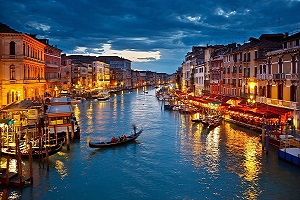
History
Uniquely among Italy’s chief cities, Venice came into being after the fall of the Roman Empire in the West. The
Lombard hordes, whose incursions into northern Italy began in AD 568, drove great numbers of mainlanders onto
the islands of the lagoon, previously the homes of itinerant fishermen and salt workers. The isolated
communities, literally islands of Veneto-Byzantine civilization, became part of the exarchate of Ravenna when it
was created in 584. When the mainland Byzantine city of Oderzo fell to the Lombards in 641, political authority
was shifted to one of the islands in the Venetian lagoon.
Food
 |
Venice is Italy, Italy is food: when in Venice, don't settle for poor quality food!
If you are looking for good food, you won't find it in fast foods. If you are looking for cheap places, you
can find cheap authentic quality food all around the city (keep in mind that a whole pizza can be bought for
5/7€!).
Traditional venetian food is Bigoli (a typical Venetian fresh pasta, similar to Udon), fettuccine (hand-made
noodles), ravioli and the similar tortelli (filled with meat, cheese, vegetables or pumpkin) and gnocchi
(potatoes-made fresh pasta), are fresh and often hand-made pasta dishes (made of eggs and wheat flour),
served together with meat sauce ... |
Culture
The culture of Venice, or Venezia as the locals call it, is characterized by the uniqueness of its people
and the influence of its history. Venice’s reputation throughout the world tends to be based on the colorful
decadence of its famed Carnival, though the city’s nickname, La Serenissima, meaning “The Most Serene
Republic,” is also appropriate.
The city’s bustling streets and passion for individuality is as notable as its noble history and quiet
suburbs.Since Venice’s early days, it has been considered one of the most important cities of the Italian
Peninsula. It’s origins as an important maritime republic solidified the city’s rich commerce and valuable
connections in the Mediterranean Sea and Far East. The noblemen of Venice were highly committed to
cultivating art, philosophy, poetry, and architecture, setting the bar for current day Venice’s deep
appreciation for all things artistic. The stunning palaces and gorgeous waters of the lagoon set the stage
in ancient Venice for countless parties and social gatherings, influencing the modern-day culture of social
enjoyment and connection.
The two most iconic symbols of Venice – the gondola and the Carnival –perfectly represent the city’s
culture.
|

|
Popultation
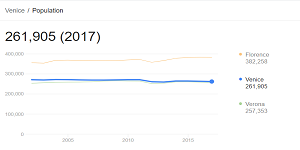 |
17, 2019. Just 53,000 people live in the historic part of the city that tourists know as Venice, down by a
third from a generation ago and dropping by about 1,000 people a year.
The population of the lagoon islands — including glass-making Murano and the Lido beach destination — is
just under 30,000, and dwindling too |
Famous attraction
 DNBC NEWS
DNBC NEWS  DNBC NEWS
DNBC NEWS